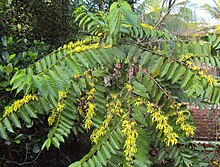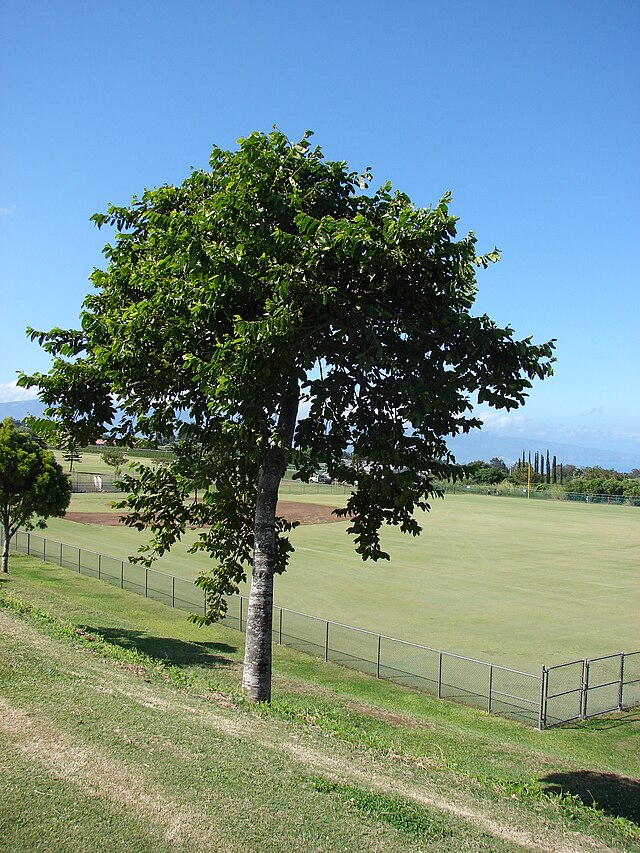Loading AI tools
Species of tree From Wikipedia, the free encyclopedia
Cananga odorata, known as ylang-ylang (/ˈiːlæŋ ˈiːlæŋ/ EE-lang-EE-lang) or cananga tree, is a tropical tree that is native to the Philippines, Malaysia, Indonesia, New Guinea, the Solomon Islands, and Queensland, Australia. It is also native to parts of Thailand and Vietnam.[1] It is valued for the essential oils extracted from its flowers (also called "ylang-ylang"), which has a strong floral fragrance. Ylang-ylang is one of the most extensively used natural materials in the perfume industry, earning it the name "Queen of Perfumes".[2][3][4]
| Ylang-ylang | |
|---|---|
 | |
| Cananga odorata in bloom | |
| Scientific classification | |
| Kingdom: | Plantae |
| Clade: | Tracheophytes |
| Clade: | Angiosperms |
| Clade: | Magnoliids |
| Order: | Magnoliales |
| Family: | Annonaceae |
| Genus: | Cananga |
| Species: | C. odorata |
| Binomial name | |
| Cananga odorata | |

The climbing ylang-ylang vine, Artabotrys hexapetalus[5] (synonym A. odoratissimus) is a woody, evergreen climbing plant in the same family, which is also a source of perfume.[6]
The name ylang-ylang is the Spanish spelling of the Tagalog term for the tree, ilang-ilang - a reduplicative form of the word ilang, meaning "wilderness", alluding to the tree's natural habitat.[7] A common mistranslation is "flower of flowers".[6]
The tree is also called the fragrant cananga, Macassar-oil plant, or perfume tree.[8][9] It is called kenanga in Malay, from Proto-Malayo-Polynesian *kanaŋa.[10] Its traditional Polynesian names include Mataʻoi (Cook Islands), Mohokoi (Tonga), Mosoʻoi (Samoa), Motoʻoi (Hawaii), and Mokosoi, Mokasoi or Mokohoi (Fiji).[11] Other traditional names include sampangi (Telugu).[12]

Cananga odorata is a fast-growing tree of the custard apple family Annonaceae. Its growth exceeds 5 m (16 ft) per year, and it attains an average height of 12 m (39 ft) in an ideal climate.[6] The compound evergreen leaves are pinnate, smooth and glossy, and 13–21 cm (5–8.5 in) long. Leaflets are oval, pointed and with wavy margins. The flower is drooping, long-stalked, with six narrow, greenish-yellow (rarely pink) petals, rather like a sea star in appearance, and yields a highly fragrant essential oil. Its pollen is shed as permanent tetrads.[13]
Cananga odorata var. fruticosa, dwarf ylang-ylang, grows as small tree or compact shrub.
The plant is native to Maritime Southeast Asia and Near Oceania, from the Philippines, Malaysia, Indonesia, New Guinea, the Solomon Islands, and Queensland, Australia. It is also native to parts of Thailand, and Vietnam. It has been introduced to other tropical regions in the Pacific Islands, South Asia, Africa, and the Americas.[1] It is commonly grown in Madagascar,[14] Polynesia, Melanesia, Micronesia, and the Comoros Islands.[15] It grows in full or partial sun, and prefers the acidic soils of its native rainforest habitat. Ylang-ylang has been cultivated in temperate climates under conservatory conditions.
In Madagascar, it is grown in plantations with Hewittia malabarica (L.) Suresh as a groundcover plant.[14]
Its clusters of black fruit are an important food item for birds, such as the collared imperial pigeon, purple-tailed imperial pigeon, Zoe's imperial pigeon, superb fruit dove, pink-spotted fruit dove, coroneted fruit dove, orange-bellied fruit dove, and wompoo fruit dove.[16] Sulawesi red-knobbed hornbill serves as an effective seed disperser for C. odorata.[17]
The essential oil is used in aromatherapy. It is believed to relieve high blood pressure and normalize sebum secretion for skin problems, and is considered to be an aphrodisiac. The oil from ylang-ylang is widely used in perfumery for oriental- or floral-themed perfumes (such as Chanel No. 5). Ylang-ylang blends well with most floral, fruit, and wood scents.
In Indonesia, ylang-ylang flowers are spread on the bed of newlywed couples. In the Philippines, its flowers, together with the flowers of the sampaguita, are strung into a necklace (lei) and worn by women and used to adorn religious images.
Ylang-ylang's essential oil makes up 29% of the Comoros' annual export (1998).[18]
Ylang-ylang is grown in Madagascar and exported globally for its essential oils.[19]
Ylang-ylang essential oil is one of the basic ingredients of macassar oil.

The fragrance of ylang-ylang is rich and deep with notes of rubber and custard, and bright with hints of jasmine and neroli, thus it is sometimes described as heavy, sweet, and carries a slightly fruity floral scent. The essential oil of the flower is obtained through steam distillation of the flowers and separated into different grades (extra, 1, 2, or 3) according to when the distillates are obtained. The main aromatic components of ylang-ylang oil are benzyl acetate, linalool, p-cresyl methyl ether, and methyl benzoate, responsible for its characteristic odor.[20]
Typical chemical compositions of the various grades of ylang-ylang essential oil are reported as:[21]
Seamless Wikipedia browsing. On steroids.
Every time you click a link to Wikipedia, Wiktionary or Wikiquote in your browser's search results, it will show the modern Wikiwand interface.
Wikiwand extension is a five stars, simple, with minimum permission required to keep your browsing private, safe and transparent.